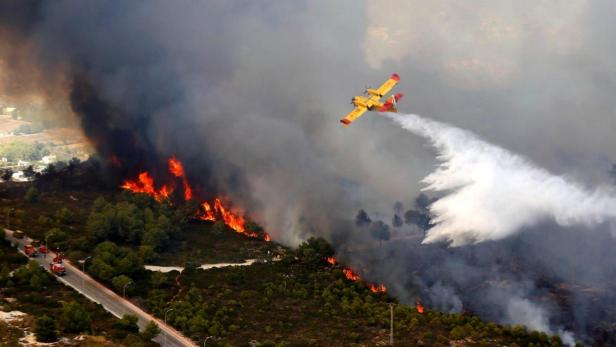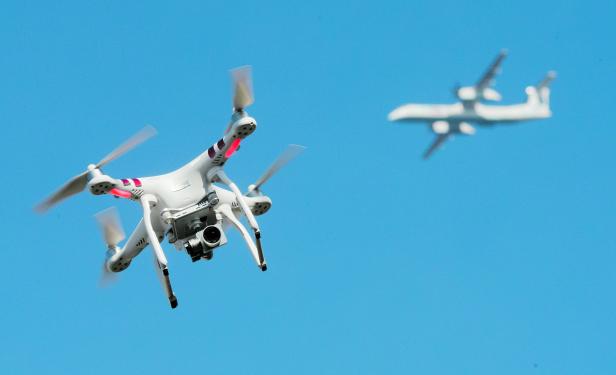Fire brigade trains around the world use drones to support them in action and detect toxins, for example. In the future, the aircraft should also be able to actively extinguish fires. The first demonstrations have already been carried out. Last year, the Chinese manufacturer Guofei Aviation tested its drone in the city of Chongqing, which was specially developed for use in fires in high-rise buildings. The fire in a ten-story test building was extinguished within 15 minutes.
The so-called 216F from the manufacturer E Hang pursues the same task. The first demonstration took place in the Chinese city of Yunfu in August 2020. The Linz outfitter Rosenbauer, on the other hand, supports the fire brigade with drones, which use the sensors to locate hotspots or even to identify hazardous substances.
Fixed-wing drone
In most cases, these developments are quadcopter or octocopter. The Institute for Aerospace Engineering at the Wiener Neustadt University of Applied Sciences, on the other hand, has developed a concept for fixed-wing drones that are to be used in different ways. In addition to the fast transport drone „Trogon“, which can carry a payload of up to 500 kilograms, a fire-fighting drone with a payload of up to 1,000 kilograms was also designed. For comparison: EHang’s drone can carry a payload of 260 kilograms.
„Now we are building an electrified demonstrator together with the Mechatronics and Diamond Aircraft Industries department, the span of which will be 4 meters,“ says fluid mechanic and project manager Markus Trenker to futurezone. The full-scale model will be 14 meters in comparison.
Opportunities for refueling
The fire-fighting drone should be able to take on various tasks. “Many Austrian fire-fighting companies have different requirements. Accordingly, it does not have to be mandatory that the drone only transports the extinguishing agent, but can also be used to detect objects, ie identify where the fire is, ”he says.
There are two specific plans for refueling the drone with water: „It can be refueled on the ground by the staff and, depending on the approval, fly autonomously to the scene of action,“ says Trenker. The other option would be to use a so-called scoop, fills up with water from a lake or river in flight, as fire-fighting planes are already doing today.

© APA / AFP / MANUEL LORENZO
Drive systems
Whether electric, combustion or hybrid: according to the specialist, the options for the respective drive system depend on the local area and the application. An ecological option is generally preferable, “but if a forest or a village is on fire, it doesn’t really matter if a drone is equipped with a kerosene generator. It is important that the fire is extinguished quickly, ”says the researcher.
Die Reichweite einer E-Drohne ist zudem bekanntlich geringer – „sie kann vielleicht 20 Minuten fliegen“, so Trenker.

© REUTERS/RAFAEL MARCHANTE
Größere Reichweite
Der Fokus auf Starrflügeldrohnen hat für die FH Wiener Neustadt einen bestimmten Grund: Helikopterdrohnen (Octocopter) erzeugen selbst keinen Auftrieb, was sich in einer geringeren Reichweite widerspiegelt. Im Gegensatz dazu weisen Starrflügeldrohnen nicht nur eine größere Reichweite, sondern auch eine größere Nutzlast, eine höhere Geschwindigkeit und bessere Stabilität auf. Die Feuerlöschdrohne soll eine Geschwindigkeit von 150 bis 200 km/h erreichen. Ziel wäre zudem, dass sie bis zu 55 Kilometer in 15 Minuten zurücklegen kann.
Starrflügeldrohnen bedürfen in der Regel aber auch einer Start- und Landebahn. Dieses Zusatzelement will die Arbeitsgruppe jedoch so weit es geht umgehen. „Wir planen Konzepte für möglichst kurze Start- und Landebahnen, falls überhaupt notwendig. Die technische Herausforderung ist das vertikale Starten und Landen“, sagt Trenker.
Basierend auf sogenannte VTOL (Vertical Take-Off and Landing), also Senkrechtstart und -landung wie bei Hubschraubern, werden spezielle Antriebssysteme erarbeitet, die einen Schwebeflug ermöglichen. Ziel ist es, beide Varianten zu verbinden und ein Fluggerät mit Flügeln zu bauen, das dennoch vertikal starten und landen kann. „Dazu müssen wir aber eine Transitionsphase zwischen aufwärts und vorwärts schaffen“, sagt er.

© APA/dpa/Julian Stratenschulte / Julian Stratenschulte
Faltbare Flügel
Da die Drohne aufgrund der Spannweite von 14 Metern im Gegensatz zu einer Helikopterdrohne zudem nur schwer hinter dem Feuerlöscheinsatzwagen nachgezogen und zum Einsatzort gebracht werden kann, soll sie über faltbare Flügel verfügen.
Aktuell evaluiert das Team Auftrieb, Widerstand und Flugverhalten des Geräts in unterschiedlichen Fluglagen. „Wir führen die numerischen Werkzeuge zusammen, also alle Softwareprogramme, mit denen die Leistung ausgerechnet wird, etwa wie schnell die Drohne steigen oder landen kann oder wie stabil sie bei einer Böe ist“, so Trenker.
The next step is the detailed design. The first model is expected to be launched in the summer. All possible drive systems, whether conventional, electric or hybrid, are currently being evaluated with regard to their suitability. According to Trenker, the actual use of the drone is conceivable in the coming years.
